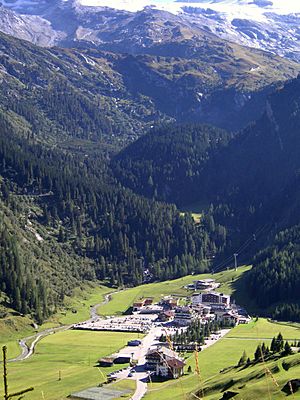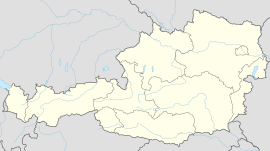Tux, Tyrol facts for kids
Quick facts for kids
Tux
|
||
|---|---|---|
 |
||
|
||
|
.
Location within Tyrol
|
||
| Country | Austria | |
| State | Tyrol | |
| District | Schwaz | |
| Area | ||
| • Total | 111.13 km2 (42.91 sq mi) | |
| Elevation | 1,281 m (4,203 ft) | |
| Time zone | UTC+1 (CET) | |
| • Summer (DST) | UTC+2 (CEST) | |
| Postal code |
6293
|
|
| Area code | 05287 | |
| Vehicle registration | SZ | |
Tux is a small town, also called a municipality, located in the Schwaz district in the beautiful Tyrol region of Austria. It's known for its stunning mountain views and popular ski areas.
Contents
Exploring Tux's Geography
The area of Tux covers the higher and largest part of the Tuxertal. This is a side valley that branches off from the Zillertal at Mayrhofen. The land of Tux reaches up to the icy peak of Olperer, which is 3,476 meters high. It also includes the 2,338-meter-high Tuxer Joch saddle. This saddle was an important crossing point between the Zillertal and Wipptal valleys long ago. Other tall mountains in Tux are the Gefrorene Wand Spitze (3,288 meters) and the Hoher Riffler (3,231 meters). The highest farms in Tux are found at 1,630 meters above sea level.
Tux is made up of five main villages:
- Tux-Vorderlanersbach
- Tux-Lanersbach
- Juns
- Madseit
- Hintertux
On January 25, 2005, the government officially changed the names of Lanersbach to Tux-Lanersbach and Vorderlanersbach to Tux-Vorderlanersbach. This was done because the whole municipality was called Tux, but there wasn't a village with that exact name.
Discovering Tux's Villages
Tux-Vorderlanersbach
Tux-Vorderlanersbach (1,300 m above sea level (AA)) is the first village you reach when driving from Finkenberg. Higher up on the mountain, you'll find the small groups of houses called Schöneben and Gemais. The farming area of Gemais, at 1,450 meters, is a protected historical site. Its buildings look much like they did in the 1600s. It grew from an old Schwaighof, which was a special type of farm for raising animals in the Alps. The 2,292-meter-high area of Geiseljoch was once a busy trade route to markets in Hall in Tirol and Innsbruck. From Vorderlanersbach, you can take a gondola lift to the Rastkogel skiing area. This area is connected to the nearby ski spots of Penken and Eggalm.
Tux-Lanersbach
Tux-Lanersbach (1,300 m above sea level (AA)) is about two kilometers past Vorderlanersbach. It's the main center for culture and business in the Tuxertal. Tux-Lanersbach is where the local government of Tux is located. It has also been a church parish since 1891. The parish church in Tux-Lanersbach was built in 1686, replacing an older church. It was later changed to the baroque style in 1750. In the southern part of the village, at the Höllenstein Hut (around 1,800 meters), there's a small farm museum. A cable lift here takes you to the Eggalm ski and hiking area.
Juns
Juns (1,400 m above sea level (AA)) is a long village about 2 kilometers further up the valley from Tux-Lanersbach. It has several small hotels and private homes. You can visit a cool show mill here that used to grind barley until just a few decades ago. Two toboggan runs, each about 5 kilometers long, come down from the Höhlenstein Hut and the Grieralm mountain pasture, ending in Juns. These runs are lit up, so you can even use them in the evening!
Madseit
Madseit (1,450 m above sea level (AA)) is located beyond Juns. It's a small place with hotels, guesthouses, and private homes. The valley gets narrower behind this little village, where the Madseitbach and Tuxerbach streams meet.
Hintertux
Hintertux (1,500 m above sea level (AA)) is the furthest village up the valley. It sits at the foot of the Hintertux Glacier, which is one of Austria's most popular places for summer skiing! It's surrounded by mountains and glaciers. The village has hotels, guesthouses, and scattered farmhouses. The Church of the Assumption (Kirche Maria Himmelfahrt) was finished in 1952. It was built where an older church had been destroyed in 1941.
In Hintertux, you'll find Europe's highest thermal baths, which have different mineral springs. Close by is the Spannagel Cave, which is over 10 kilometers long. It's the largest natural cave in the Austrian Central Alps. The cave is protected and can only be visited with a guided tour. The Tuxer Ferner glacier has a ski area that is open all year round with many lifts. This area is a great starting point for many walks and high mountain tours. The Hintertux Glacier Ski Region is part of the Zillertal 3000 ski region. It's popular with skiers in both summer and winter. In 2006, Hintertux had 178 people living there. Until 1926, it was part of the parish of Schmirn am Brenner.
Neighboring Towns and Villages
Tux is close to these other places:
- Finkenberg
- Hippach
- Kolsassberg
- Navis
- Schmirn
- Schwendau
- Wattenberg
- Weerberg
Tux's Rich History
The Tuxer valley was first written about in official records in the year 1280.
Early Settlers in Tux Valley
The Tuxer valley was discovered in prehistoric times, meaning a very long time ago! We know this because of different items found from the middle Stone Age. The first people to settle in the valley were probably the Breuni. They were part of the Raeti tribe and came from the Wipptal area. Shepherds and miners also settled in the valley. They traveled over the Tuxer Joch from the Schmirn valley and cleared forests to make land for farming.
In 889, the Tux valley, along with other parts of the Zillertal, became part of the Archdiocese of Salzburg. In 1280, the name Tux (Tukkes) was first mentioned in records. The name originally meant "pure water" and was later used for the whole valley. It likely comes from an old word, teg, which means "running," "flowing," or "melting away." The first farms were called Schwaighof farms. They had to pay their taxes with things like livestock instead of money.
The furthest part of the valley between Lanersbach and Hintertux was, until 1438, controlled by the courts of Matrei am Brenner and later Steinach am Brenner. Hintertux was part of the parish of Schmirn until 1926. In 1926, Hintertux joined with Lanersbach and the mining area of Lämperbichl to form the municipality of Tux.
Economy: How Tux Makes a Living
Farming in Tux
The green meadows and mountain pastures in the Tux valley are still used for farming today. However, for most farms, this is now a second job, not their main way to earn money.
Tourism: Tux's Main Industry
Tourism is the most important part of Tux's economy today. Many hotels, restaurants, and places to stay have been built here. Three ski areas have been developed for ski tourism:
- The Eggalm region opened in 1961.
- The Hintertux Glacier opened in 1968.
- The Rastkogel opened in 1984.
Since 2001, the Rastkogel area has been connected to the Penken Ski Region by a shuttle lift. In the 2000s, the number of ski lifts and their capacity greatly increased. The Hintertux Glacier has always been open for skiing all year round. It's also very important that the Tux ski areas are connected with those towards Finkenberg and Mayrhofen (Penken). After Mayrhofen, Tux has the second-highest number of visitors staying overnight in the Zillertal.
The Old Magnesite Factory
From 1927 to 1976, the Tux Magnesite Mine was located about 500 meters above Vorderlanersbach. It was the highest mine of its kind in Europe. Up to 400 workers mined magnesite both above ground and underground. Special cableways carried workers and materials between the factory, Lanersbach, and a loading station near Mayrhofen in the Zillertal. On the Schrofenalm, about 500 meters from the factory, there was a small community. It had homes, a school, a grocery store, a cinema, and other facilities for the workers and their families. When the factory closed in 1976, it was completely taken down, and the land was returned to its natural state. All that remains are St. Barbara's Chapel, built in 1947, and two old worker's houses, called the Schrofenhäuser.
Getting Around Tux
You can reach Tux by road from Mayrhofen. From the Mayrhofen station on the Ziller Valley Railway, there is a bus service. The closest main Austrian train station is at Jenbach. This is also where you can catch the Ziller Valley Railway. Within the Tux valley, there is a free bus service called the Tuxer Sportbus. It runs during the day between Vorderlanersbach and Hintertux. In the winter months, there is also a Nightliner bus that runs until 2 a.m., but you have to pay for that one.
See also
 In Spanish: Tux (Austria) para niños
In Spanish: Tux (Austria) para niños



